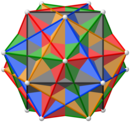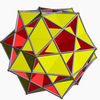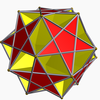| Compound of five cubes | |
|---|---|
 (Animation, 3D model) | |
| Type | Regular compound |
| Coxeter symbol | 2{5,3}[5{4,3}][1][2] |
| Stellation core | rhombic triacontahedron |
| Convex hull | Dodecahedron |
| Index | UC9 |
| Polyhedra | 5 cubes |
| Faces | 30 squares (visible as 360 triangles) |
| Edges | 60 |
| Vertices | 20 |
| Dual | Compound of five octahedra |
| Symmetry group | icosahedral (Ih) |
| Subgroup restricting to one constituent | pyritohedral (Th) |

The compound of five cubes is one of the five regular polyhedral compounds. It was first described by Edmund Hess in 1876.
It is one of five regular compounds, and dual to the compound of five octahedra. It can be seen as a faceting of a regular dodecahedron.
It is one of the stellations of the rhombic triacontahedron. It has icosahedral symmetry (Ih).
Geometry
[edit]The compound is a faceting of a dodecahedron (where pentagrams can be seen correlating to the pentagonal faces). Each cube represents a selection of 8 of the 20 vertices of the dodecahedron.

|

|

|

|
| Views from 2-fold, 5-fold and 3-fold symmetry axis | |||
If the shape is considered as a union of five cubes yielding a simple nonconvex solid without self-intersecting surfaces, then it has 360 faces (all triangles), 182 vertices (60 with degree 3, 30 with degree 4, 12 with degree 5, 60 with degree 8, and 20 with degree 12), and 540 edges, yielding an Euler characteristic of 182 − 540 + 360 = 2.
Edge arrangement
[edit]Its convex hull is a regular dodecahedron. It additionally shares its edge arrangement with the small ditrigonal icosidodecahedron, the great ditrigonal icosidodecahedron, and the ditrigonal dodecadodecahedron. With these, it can form polyhedral compounds that can also be considered as degenerate uniform star polyhedra; the small complex rhombicosidodecahedron, great complex rhombicosidodecahedron and complex rhombidodecadodecahedron.
 Small ditrigonal icosidodecahedron |
 Great ditrigonal icosidodecahedron |
 Ditrigonal dodecadodecahedron |
 Dodecahedron (convex hull) |
 Compound of five cubes |
 As a spherical tiling |
The compound of ten tetrahedra can be formed by taking each of these five cubes and replacing them with the two tetrahedra of the stella octangula (which share the same vertex arrangement of a cube).
As a stellation
[edit] The yellow area corresponds to one cube face. |
This compound can be formed as a stellation of the rhombic triacontahedron. |
See also
[edit] |
Footnotes
[edit]- ^ Coxeter 1973, pp. 49-50.
- ^ Coxeter 1973, p 98.
References
[edit]- Cromwell, Peter R. (1997), Polyhedra, Cambridge, p. 360
{{citation}}: CS1 maint: location missing publisher (link). - Harman, Michael G. (c. 1974), Polyhedral Compounds, unpublished manuscript.
- Skilling, John (1976), "Uniform Compounds of Uniform Polyhedra", Mathematical Proceedings of the Cambridge Philosophical Society, 79 (3): 447–457, Bibcode:1976MPCPS..79..447S, doi:10.1017/S0305004100052440, MR 0397554, S2CID 123279687.
- Cundy, H. and Rollett, A. "Five Cubes in a Dodecahedron." §3.10.6 in Mathematical Models, 3rd ed. Stradbroke, England: Tarquin Pub., pp. 135–136, 1989.
- Coxeter, H. S. M. (1973), Regular Polytopes (3rd ed.), Dover edition, ISBN 0-486-61480-8, 3.6 The five regular compounds, pp.47-50, 6.2 Stellating the Platonic solids, pp.96-104
External links
[edit]- MathWorld: Cube 5-Compound
- George Hart: Compounds of Cubes
- Steven Dutch: Uniform Polyhedra and Their Duals
- Klitzing, Richard. "3D compound".